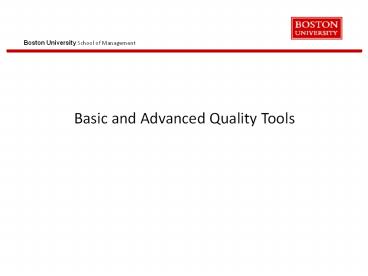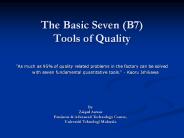Basic and Advanced Quality Tools - PowerPoint PPT Presentation
1 / 32
Title:
Basic and Advanced Quality Tools
Description:
Basic and Advanced Quality Tools * * * * * * * Boston University School of Management Boson University School of Management ... – PowerPoint PPT presentation
Number of Views:341
Avg rating:3.0/5.0
Title: Basic and Advanced Quality Tools
1
Basic and Advanced Quality Tools
2
7 Basic Tools Process Flow Diagram
no
start
yes
end
Start and End Points
Flows
Tasks
Decision Points
Waits
3
Lab Flow
4
MBA Application Process
5
Process Flow Diagram Doing Laundry
no
Dirty clothes
Need supplies?
Need quarters?
yes
Get change
Purchase supplies
yes
start
Wait for clothes to wash
Dark?
washer Available?
yes
Start machine
Insert quarters
Add detergent
Load washer
yes
no
no
Add detergent
Load washer
Add bleach
Start machine
Insert quarters
Wait for washer
Wait for clothes to dry
Empty washers
Load dryer
Add dryer sheet
Insert quarters
Start machine
Remove clothes
Dryer available?
Shirt?
Hang shirt
yes
Wait for dryer
no
Additional items?
Fold item
no
end
yes
6
Process Flow Diagram Doing Laundry, Outsourcing
Option
Wait for clothes to dry
Call Mom
Give dirty clothes to Mom
Get clean clothes from Mom
end
start
7
Checksheet
8
Checksheet
9
Checksheet
X
X
X
X
X
X
X
X
X
X
X
X
X
X
X
X
X
10
Histogram/Bar Chart
Frequency
Measurement
11
Histogram/Bar Chart
12
Pareto Chart
13
Pareto Chart
14
Pareto Chart
15
Scatterplot
16
Scatterplot
17
Scatterplot
18
Cause-and-Effect Diagram
19
Cause-and-Effect Diagram
20
Advanced Tools for Quality
21
Affinity Diagram
Groups Similar Ideas
Listen effectively (2)
Understanding of interdependencies
Share
Give and receive feedback
Communicate what was learned
Develop skills of flexible learner
Play own team role
Getting teams to work together is HARD
Manage team process
Group grades are result of group work
Contract on productive exercise
Evaluate own contribution to group effort
Improving team performance will improve product
Integration of multi-functional issues (2)
Active participation in learning
Learning efficiency
There is value to cooperation (and competition)
Learn own strengths/weak- nesses in groups
Coach
Different contributions add to solutions
How teams work
Several minds are better than one
Work with people with different skills
competencies
Develop Self confidence
Develop confidence in working with people
Evaluate team progress
Control bulldozers, bring out quiet members
Manage own reactions to diversity
Deal with conflict
Take Responsibility
Respect alternative viewpoints
Focus is on team goal
Team planning (time mgt group planning)
Equitability in decision- making
Letting go of own ideas working on team ideas
Take corrective action
Negotiate
Respect other opinions
Trust
Complex problem solving
Team roles
How to make team work better
22
Listen effectively (2)
Give and receive feedback
Develop skills of flexible learner
Communicate what was learned
Group grades are result of group work
Complex problem solving
Evaluate own contribution to group effort
Getting teams to work together is HARD
Improving team performance will improve product
Active participation in learning
Learn own strengths/weak- nesses in groups
Several minds are better than one
There is value to cooperation (and competition)
Learning efficiency
Coach
Different contributions add to solutions
Negotiate
Equitability in decision- making
Develop confidence in working with people
Manage own reactions to diversity
Letting go of own ideas working on team ideas
How teams work
Take Responsibility
Work with people with different skills
competencies
Focus is on team goal
Team roles
Share
Respect alternative viewpoints
Develop Self confidence
Understanding of interdependencies
Respect other opinions
Integration of multi-functional issues (2)
Trust
23
Team Learning Skills and Dimensions
New Ways to Learn
The Theory and Function of Teams
Individual Skills
How to Manage Teams
Process
Communication
Enhanced Learning Skills
Manage team process
Listen effectively (2)
Teamwork
Why Teams Are Important
Develop skills of flexible learner
How to make team work better
Evaluate own contribution to group effort
Give and receive feedback
Improving team performance will improve product
Complex problem solving
Contract on productive exercise
Learn own strengths/weak- nesses in groups
Bottom Line
Communicate what was learned
Several minds are better than one
Team Concepts and Theory
Group grades are result of group work
Active participation in learning
Play own team role
Coach
How teams work
Different contributions add to solutions
Learning efficiency
Team planning (time mgt group planning)
Getting teams to work together is HARD
Negotiate
Team roles
Equitability in decision- making
Tolerance Respect
Control bulldozers, bring out quiet members
There is value to cooperation (and competition)
Develop confidence in working with people
Manage own reactions to diversity
Letting go of own ideas working on team ideas
Deal with conflict
Take Responsibility
Work with people with different skills
competencies
Content
Focus is on team goal
Evaluate team progress
Share
Enhanced Content Integration
Respect alternative viewpoints
Take corrective action
Understanding of interdependencies
Develop Self confidence
Respect other opinions
Integration of multi-functional issues (2)
Trust
Harness benefits of team process
24
Tree Diagram
Breaks large activities into subtasks
25
Work Breakdown Structure
Breaks large activities into subtasks
26
Radar Chart
Track performance along multiple dimensions
27
Forcefield Analysis
Identifies factors supporting and blocking change.
1000 a.m. Discharging
Driving Forces
Restraining Forces
Increases beds for ER admits
Fear that labs will be abnormal
Pharmacy unwilling to change processes
Decreases nursing pressure at shift changes
Concern that patients will feel rushed
28
Interrelationship Diagraph
Shows relationships among factors
29
Prioritization Matrix
Weights factors according to identified criteria
to permit comparison.
5
7
2.5
5.75
3.5
Criteria
Effectiveness
Total/Average
Feasibility
Tasks
Time
Cost
Excellent 9
Fair 3
Poor 1
30
Gantt Chart
Shows temporal relationships in a project
31
The PDCA Cycle (or Deming Cycle or Shewhart Cycle)
PDCA Step Tools
P L A N 1 Select Theme Brainstorming, Affinity Diagram, Project Tools
P L A N 2 Data Collection Analysis Flow Charts, Checksheets, Histograms, Run Charts, Scatterplots, Pareto Graphs
P L A N 3 Causal Analysis Cause-and-Effect Diagrams
D O 4 Solution Planning Implementation Prioritization Diagrams, Tree Diagrams
C H E C K 5 Evaluation of Effects Flow Charts, Checksheets, Histograms, Run Charts, Scatterplots, Pareto Graphs
A C T 6 Standardization Control/Run Charts
A C T 7 Reflection on Process Affinity Diagrams
32
The Six Sigma DMAIC Cycle
DMAIC Step Tools
Define 1 Select Theme Brainstorming, Affinity Diagram, Project Tools
Measure 2 Data Collection Analysis Flow Charts, Checksheets, Histograms, Run Charts, Scatterplots, Pareto Graphs
Analyze 3 Causal Analysis Cause-and-Effect Diagrams
Improve 4 Solution Planning Implementation Prioritization Diagrams, Tree Diagrams
Improve 5 Evaluation of Effects Flow Charts, Checksheets, Histograms, Run Charts, Scatterplots, Pareto Graphs
Control 6 Standardization Control/Run Charts
Control 7 Reflection on Process Affinity Diagrams










![[PDF] Telehealth Essentials for Advanced Practice Nursing 1st Edition Full PowerPoint PPT Presentation](https://s3.amazonaws.com/images.powershow.com/10102405.th0.jpg?_=20240820064)




















